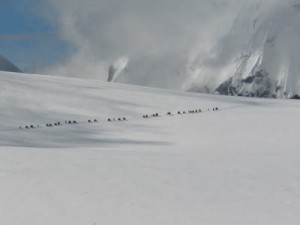
A yak caravan crossing the Nangpa Pass.
The shooting took place just over a year after a 17-year old nun, Kelsang Namtso, was shot dead by PAP border guards on September 30, 2006, in an incident that led to widespread condemnation of China after it was captured on film by a climber. Kelsang Namtso’s death follows other incidents where Tibetans had been fired upon by PAP when attempting to cross the pass into exile, in 2005 and 2002. The shooting on October 18 indicates that firing at unarmed Tibetans escaping into exile, including children, is still regarded by the Chinese authorities as ‘normal border management’, as Beijing informed Western governments last year.
The group of more than 30 Tibetans was walking across the glaciated Nangpa Pass at around 11:30 in the morning of October 18 when they were spotted by PAP troops guarding the border. The Nangpa Pass, at nearly 19,000 ft, is a trading route in the Himalayas between Tibet and Nepal west of Mount Chomolungma (Everest) commonly used by Tibetans fleeing into exile. One of the Tibetans, a monk in his twenties, and other members of the group, told ICT that they saw several people starting to chase them carrying what they described as ‘long guns’. Another Tibetan, a nun, said that she heard the armed personnel shouting at the group to stop: “At least one bullet passed by me and I was happy not to be hit,” she told ICT. The Tibetans dropped their belongings and ran with the border police pursuing them. Several members of the group independently said that they saw around seven police officials firing at them.
One source said that climbers at advance base camp, Mount Cho Oyu, which overlooks the pass, heard the gun-fire. This is a parallel to the incident on September 30, 2006, when a group of international climbers, guides and Sherpas witnessed the shooting of Kelsang Namtso from the same location – their accounts of what happened focused international attention on the dangers of Tibetans’ journeys into exile.
Most of the group arrived safely on the Nepalese side of the border, but seven Tibetans who were finding it difficult to finish the journey were captured and detained before the shooting began. This included a Tibetan man in his late twenties, who was ill before beginning the journey, and who fell sick during the journey. He is now in hospital. One of the Tibetans who escaped told ICT: “One of the monks and other friends carried him [for part of the way across the Pass] as he could not walk because both of his eyes turned white and his joints were not working properly. They left him there with some barley and dry meat and his medicine and told him that the yak traders [who cross the pass regularly] would help him.”
Tibetans captured while attempting to escape from Tibet face beatings and imprisonment in detention centers or military barracks for periods ranging from several weeks to several months, in some cases longer.
On September 30, 2006, a group of Tibetans came under fire from PAP troops as they were crossing the same pass into exile and a young nun was shot dead. News of the death of Kelsang Namtso, who had been escaping into exile to see the Dalai Lama and to attend a nunnery in India, was broadcast all over the world, leading to strong protests by the US and EU governments to Beijing. The video footage of the shooting taken by a Romanian cameraman from advance base camp, Cho Oyu, refuted official claims that the troops fired ‘in self-defence’. The Chinese authorities stated in response that the shooting was ‘normal border management’. (ICT report, Video footage of Nangpa Pass shooting refutes official Chinese statement – October 13th, 2006).
The shooting was not unprecedented; in a report published earlier this year, ICT documented that a group of around 50 Tibetans were fired upon near the Tibetan town of Dingri near the border with Nepal in October 2005. Although none were injured, around 23 members of the group were detained and beaten in custody. In 2002, there were separate eyewitness reports by Western mountain climbers of Chinese border police firing upon Tibetan refugees as well as pursuing refugees across the Nangpa Pass into Nepalese territory. (Dangerous Crossing: Conditions impacting the flight of Tibetan refugees – 2006 Update).
Approximately 2,500 to 3,500 Tibetans make the dangerous journey through the Himalayas into exile in Nepal, and from there to India, each year. For many, the main or only purpose of their journey is to see their religious leader, the Dalai Lama. A high percentage of the new refugees are children sent by their parents to study in Tibetan exile schools due to inadequate or unaffordable schools in Tibet, and monks and nuns seeking to practice their religion in exile following persecution or repression of religious practice in Tibet.

